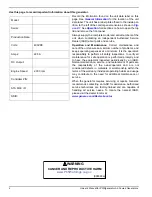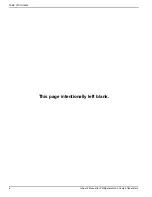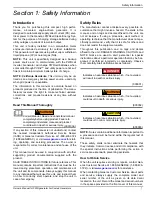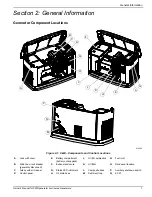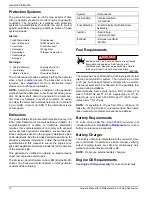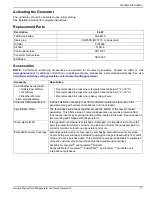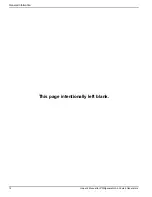
General Information
10
Owner’s Manual for PWRgenerator Air-Cooled Generators
Protection Systems
The generator may need to run for long periods of time
with no operator present to monitor engine or generator
conditions. The generator is equipped with protection
systems to automatically shut down the unit to protect
against potentially damaging conditions. Some of these
systems include:
Alarms
:
Warnings:
The control panel contains a display alerting the operator
when a fault condition occurs. The above list is not all-
inclusive. See
for more information about
alarms and control panel operation.
NOTE:
A warning indicates a condition on the generator
which should be addressed, but will not shut down gener-
ator. An alarm shuts down the generator to protect sys-
tem from any damage. In event of an alarm, an owner
can clear the alarm and restart generator prior to contact-
ing an IASD. Contact an IASD if the intermittent issue
occurs again.
Emissions
The United States Environmental Protection Agency (US
EPA) (and California Air Resources Board (CARB), for
engines/equipment certified to California standards)
requires this engine/equipment to comply with exhaust
and evaporative emissions standards. Locate the emis-
sions compliance decal on the engine to determine appli-
cable standards. See the included emissions warranty for
emissions warranty information. Follow the maintenance
specifications in this manual to ensure the engine com-
plies with applicable emissions standards for the duration
of the product’s life.
This generator is certified to operate on liquid propane
vapor fuel or pipeline natural gas.
The Emission Control System code is EM (Engine Modifi-
cation). The Emission Control System on this generator
consists of the following:
:
Fuel Requirements
The engine has been fitted with a dual fuel electronic fuel
injection control (EFIC) system. The unit will run on NG
or LP gas, but has been factory-configured to run on NG.
The fuel system will be configured for the available fuel
source during installation.
Recommended fuels should have a BTU content of at
least 1,000 BTUs per ft
3
(37.26 megajoules per m
3
) for
natural gas, or at least 2,500 BTUs per ft
3
(93.15 mega-
joules per m
3
) for LP gas.
NOTE:
If converting to LP gas from NG, a minimum LP
tank size of 250 gal (946 L) is recommended. See instal-
lation manual for complete procedures and details.
Battery Requirements
12 volts, Group 26R Wet Cell 540CCA minimum (not
included with unit). See
for correct
battery maintenance procedures.
Battery Charger
The battery charger is integrated into the converter mod-
ule in all models. It operates as a smart charger, verifying
output charging levels are safe and continuously opti-
mized to promote maximum battery life.
NOTE:
Do not use external battery chargers.
Engine Oil Requirements
See
for correct oil viscosity.
•
High Temperature
•
Low Oil Pressure
•
Overcrank
•
Overspeed
•
Overvoltage
•
Undervoltage
•
Overload
•
Underspeed
•
RPM Sensor Loss
•
Controller Fault
•
Wiring Error
•
Stepper Overcurrent
•
Charger Warning
•
Low Battery
•
Battery Problem
•
Exercise Set Error
•
USB Warning
•
Download Failure
System
Components
Air Induction
- Intake manifold
- Air cleaner
Fuel Metering
- Electronically controlled mixer
assembly
Ignition
- Spark plug
- Ignition module
Exhaust
- Exhaust manifold
- Muffler
(000105)
Explosion and Fire. Fuel and vapors are extremely
flammable and explosive. Add fuel in a well
ventilated area. Keep fire and spark away. Failure
to do so will result in death or serious injury.
DANGER


